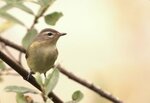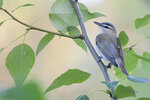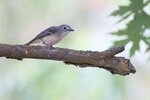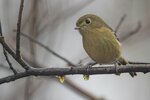



Vireos are relatively common songbirds in Thurston County in the summer. There are 15 vireo species in North America, of which we have four. Only one of them is here year-round. Vireos are smallish birds, about sparrow-sized, have a pointed bill with a slight hook, and have drab coloration without any really bold markings. The sexes of vireo species look alike.
They are not often seen, both because they have nondescript plumage, but also because they tend to occupy dense brush and leafy deciduous trees. Their main food targets are crawling insects and larvae, so you don’t often see them flying around (in contrast to flycatchers and warblers, for example). They’re hard to see; therefore, most bird watchers depend on their song to alert us to their presence.
Their songs are interesting to me because, in one way or another, most vireo songs include their name (“vireo”). Sometimes I hear a vireo calling and it to me it sounds like, “see me, here I am, vireo.” The notes are clear, not buzzy, and beautiful, but their songs are often short. It is definitely worth reviewing vireo songs on your Merlin app.
Two species are summer residents, having migrated here from southern Mexico and Central America. The Warbling Vireo, as its name implies, has a song that might remind you of the loud burbling notes of a warbler or a finch. You will often find these birds in willows and other leafy trees, where they move about slowly, seeking out larvae that are feeding on fresh green leaves. These birds are gray above with a lighter belly. They have dark eyes and a white eyebrow stripe above the eye. They might remind you of a chickadee, but with no black feathers and a much thicker bill.
Cassin’s Vireo is a second species that is also likely to be found moving slowly through leafy trees seeking larvae and other prey. It’s about the same size as the warbling vireo, but its appearance is much different. Its back and wings are gray-green with two light wing bars and sometimes, a slightly blueish head. Instead of an eyebrow, it appears to have spectacles. You might know this bird species by its old name, Solitary Vireo. In 1997 the single species was divided into three species and our western birds were given a new name.
Another Washington vireo species is the Red-eyed Vireo. It is uncommon in our county but very common along streams in Eastern Washington. It’s a bit larger than the above species and its red eye usually is very noticeable. It has a greenish back and wings (no wing bars), a whitish belly and a bold white eyebrow stripe that contrasts with a black stripe above and through the eye. For this bird, you can definitely hear the name “vireo” in its song and in willows along streams, it seems at times to be loudly calling its presence.
Our final vireo species is quite different from the above three. It is Hutton’s Vireo and non-migratory; it’s the one that’s here all year-round. It’s smaller, a little larger than a kinglet, and it looks somewhat like a Ruby-crowned Kinglet but stockier and with a bolder bill. Its back and wings are dark olive green, with two wing bars, and its belly has a gray-greenish wash. This vireo has no eyebrow stripe but does have a broken light ring around its eyes. It’s an active bird and, in winter, it sometimes travels with mixed flocks of chickadees and kinglets.
Hutton’s Vireo vocalization (it is a song, but it’s not very song-like) is a sharp “treweet,” repeated a few times. This species is found in a wider variety of habitats than all the other vireos described. It might be in bushes, conifer trees of varying height and deciduous trees along stream corridors.
By now you might be wondering why I’m writing about vireos. After all, they aren’t in our yards and don’t come to bird feeders, and they’re rather nondescript and hard to see and identify. And that’s just the point; they are a challenge to our powers of observation – so seeing them is a treat, and so is learning to recognize their songs. When you recognize the call of a “vireo” as you pass by, you will be delighted.
Once in a while, one of the eastern species of vireos wanders into Washington. This happened earlier this spring and the bird, a Yellow-throated Vireo, was spotted and identified in Neah Bay by Liam Hutcheson, our column photographer. It is very rare, only the third state record, and made a great addition to Liam’s 2023 Big Year list.
George Walter is environmental program manager at the Nisqually Indian Tribe’s natural resources department; he also has a 40+ year interest in bird watching. He may be reached at george@theJOLTnews.com
Photos for this column are provided by Liam Hutcheson, a 16-year-old Olympia area birder and avid photographer.
2 comments on this item Please log in to comment by clicking here
GinnyAnn
I appreciate reading about the birds in our area and seeing photos of the birds that sing in our trees and bushes. I can never find the birds I hear singing. I only can identify a few species of birds on sight, and none by their songs. I'd love to learn more about all the different song birds. What is the Merlin app? Is it free? I'm afraid to download something to my phone if it's not something recommended and explained to me first.
I'm an older lady living in Jubilee, but have always wanted to learn which bird was which. Nobody has ever shown me more than the basic backyard visitors. Books don't help because so many birds look the same - plus they don't hold still while I frantically search through my book for their picture. Thanks for working for the Nisqually Tribe and for contributing to the Jolt so we can learn more about the little singers.
Ginny
Friday, June 30, 2023 Report this
Georgewalter
This is for Ginny, or anyone else thinking about adding the Merlin app to their smart phones:
This app is free and has not other negative implications. No reason to be afraid at all. Just follow the link in the article, or type Merlin into your phone's app store When you get the app, play around with it a bit. Each bird account includes a map to help you better determine what is likely in our area.
Some of my JOLT articles from last year included suggestions on bird I.D. I think they're still available if you search.
Tuesday, July 4, 2023 Report this